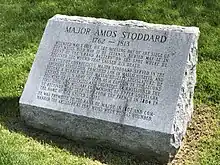Amos Stoddard
Amos Stoddard (October 26, 1762 – May 11, 1813) was a career United States Army officer who served in both the American Revolutionary War and the War of 1812, in which he was mortally wounded.
In 1804, Stoddard was the Commandant of the military district of Upper Louisiana, after the Louisiana Purchase.
Biography
Stoddard was born in Woodbury, Connecticut, to Anthony and Phebe (Reed) Stoddard. He saw combat as a young man in the American Revolutionary War, and afterwards represented Hallowell, Maine, in the Massachusetts House of Representatives.[1][2] In June 1798, he was commissioned as a captain of artillery in the US Army.
Circa 1800 Stoddard commanded Fort Sumner in his home town of Portland, Maine as a company commander in the Regiment of Artillerists.[3]
In 1800 Spain ceded Louisiana back to France in the Third Treaty of San Ildefonso. Three years later, Napoleon promptly sold it to the United States to obtain money to continue his campaigns in Europe. Nevertheless, Spain had continued to govern the territory and refused to give Lewis and Clark permission to explore it. This forced Lewis and Clark to spend the winter of 1803-04 at Camp Dubois, in what is now Illinois.
On November 30, 1803, in New Orleans, Spain formally turned the territory over to France, which governed it for only 20 days before surrendering it to the United States on December 20, 1803.[4]
During the Three Flags Day ceremony on March 9–10, 1804, in Saint Louis, Stoddard represented both the United States and France. Stoddard noted about the residents:
- Nothing ever restrains them from amusement which usually commences early in the evening, and is seldom suspended till late the next morning.[5]
Stoddard held the position as a military commander until October 1, 1804, when the territory came under William Henry Harrison, in a transitional civil jurisdiction as part of the Indiana Territory. He was promoted to the rank of major in June 1807.
He was a member of Kennebec Lodge #5 A. F. and A. M in Hallowell, Maine,[6] and delivered the oration at the first anniversary of the chartering of the lodge on St. John's Day 1797.[7]
Service at Fort Meigs
In the winter of 1812-13, after war had begun with Great Britain, Major Stoddard accompanied Governor Harrison to the Maumee rapids in Ohio, where they built Fort Meigs. Stoddard commanded the fort's artillery.
From May 1 to May 9 of 1813, Fort Meigs was attacked by a large British and Indian force from Canada under Major General Henry Procter (see Siege of Fort Meigs). Early on, Stoddard was wounded in the leg by shrapnel. He survived long enough to see the British retreat, but on May 11 he died from tetanus.
Tributes

According to a diary kept by Captain Daniel Cushing, Major Stoddard was buried in front of the Grand Battery at Fort Meigs. A stone monument inside the fort honors his memory today. Stoddard County, Missouri, was named for him.[8]
References
- A History of the Law: The Courts, And the Lawyers of Maine, from Its First Colonization to the Early Part of the Present Century by William Willis ISBN 1-58477-628-5
- 'Old Hallowell on the Kennebac,' Emma Huntington Nason, 1909, pg. 136-137
- Wade, Arthur P. (2011). Artillerists and Engineers: The Beginnings of American Seacoast Fortifications, 1794-1815. CDSG Press. p. 86. ISBN 978-0-9748167-2-2.
- The Spanish Regime in Missouri by Louis Houck - 1909
- The Urban Frontier: The Rise of Western Cities, 1790-1830 By Richard C. Wade - 1996 ISBN 0-252-06422-4
- "History of Kennebec Lodge A.F. & A.M. - Hallowell, Maine". Archived from the original on 2014-03-16. Retrieved 2012-10-21.
- Stoddard, Amos; Robinson, Howard Smith; Me.), Freemasons Kennebeck Lodge (Hallowell (1797). A Masonic Address, Delivered Before the Worshipful Master, Officers and Brethren, of the Kennebeck Lodge, in the New Meeting-house, Hallowell, Massachusetts; June 24th, Anno Lucis 5797. Brother Howard S. Robinson.
- Eaton, David Wolfe (1918). How Missouri Counties, Towns and Streams Were Named. The State Historical Society of Missouri. p. 366.
External links
| Political offices | ||
|---|---|---|
| Preceded by none |
Commandants of the Louisiana District 1803-1804 |
Succeeded by William Henry Harrison (Indiana Territory) |